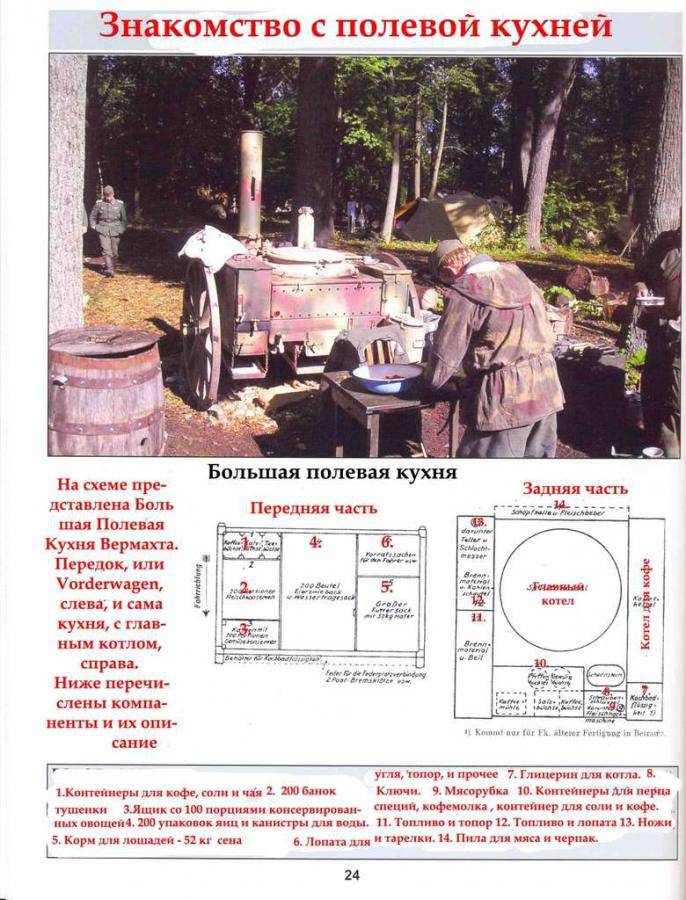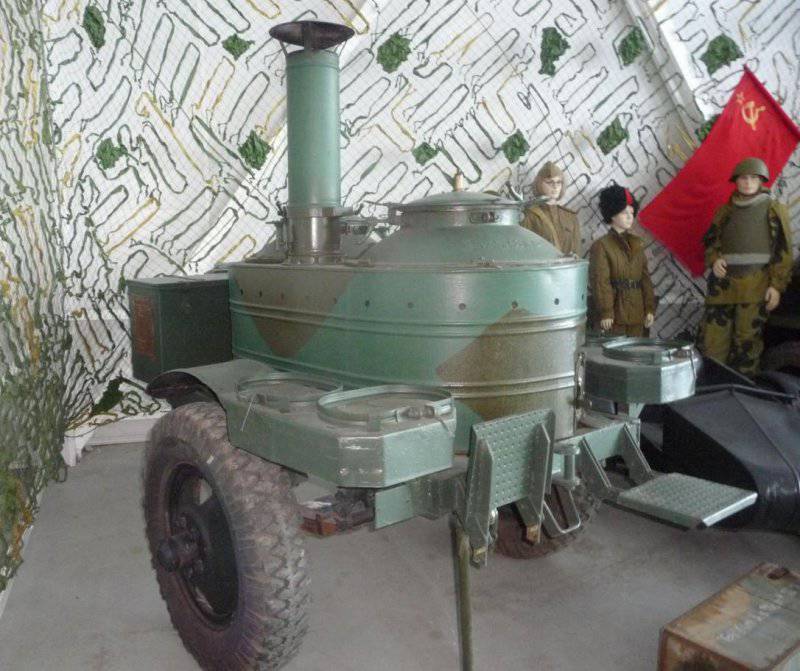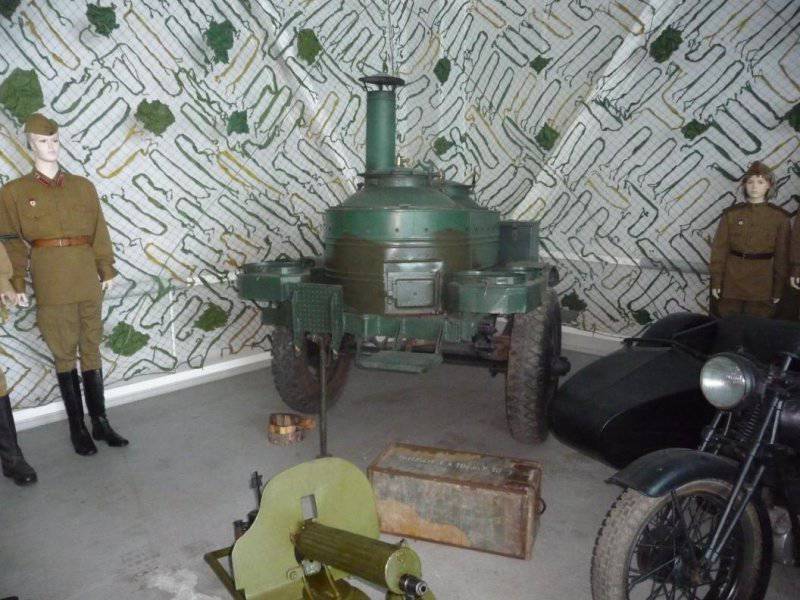The last spoonful of porridge
Anton Turchanovich again and again stubbornly sent his field kitchen drawings, explanatory notes to all military departments. But they remained deaf to the new project of a lieutenant colonel from distant Zhmerynka. The inventor understood that his offspring was being dragged down by military officials lobbying the interests of competing firms that were promoting their projects and were not going to give up. From everywhere came refusals. But the inventor believed in his creation. And he was right: his military field kitchen will be used on the fronts of the First and Second World Wars, will become the basis for modern analogues.
Without a complete meal, fighting is just as impossible as without weapons.
"In the kitchen, the usual army cronyism reigned: everyone who was close to the ruling clique enjoyed benefits. The wardens walked with faces that were glossy with fat. All orderlies had stomachs like drums. There were flagrant disgraces" soldier Schweik. "
In the Russian-Turkish war, doctors had to treat soldiers with the usual “rusk diarrhea”: prolonged use of rusks led to constant irritation of the intestines and stomach and damage to their mucous membranes, on which rusks acted like sand.
Since 1901, according to the highest order, the army has received new modifications of Kryshtov, Brun and S-n’s kitchens on wheels: infantry-artillery (four-wheeled) and cavalry (two-wheeled), which won the competition, which in 1896 year held the Ministry of War.
And then the most interesting thing began - the winner of the ministerial competitions could not win the hearts of the military because the kitchen was too heavy and slow-moving. The inventors for some reason decided that for army units a kitchen that could feed around 240 people should have been gigantic in size. The hearth kitchen was made out of. iron casing with asbestos gasket, which strengthened the copper pot.
The infantry-artillery kitchen was divided into two parts: in the first there was a food box, in the second part there was a copper boiler with a tight iron lid, two cranes and a folding chimney. The total weight of the "fully loaded kitchen will be: with raw vegetables: 71 front. 10 fn; when canned vegetables 67 front. 30 fn".
A significant drawback of the kitchen was that it was necessary to take turns preparing the first and second courses: the boiler was alone. The cooking time for dinner was stretched for five hours or more. This is in wartime conditions - a luxury. "Many troops. Parts expressed that in the kitchen there was not enough 2 boiler for cooking at the same time using liquid food and porridge; others pointed out that it was highly desirable to cook in the kitchen and boiling water for tea," the Military Encyclopedia states.
There were so many complaints about the kitchen that the Central Directorate Directorate Directorate appealed to other manufacturers and manufacturers with the request to develop a fundamentally new type of infantry-artillery military-field kitchen with two boilers. And the total weight of the kitchen should be no more than 34 pounds.
Representatives of the military department and potential customers considered the cooked porridge and borscht more meticulously during the final tests. However, this did not affect the results of the competition because Kryshtov, Brun and S-n did not stand aside and again offered its project. And won the second time! Despite the fact that in addition to it, new models of cars were offered by several of the largest factories - Putilovsky, Verkhne-Volzhsky, St. Petersburg Carriage Works.
In its conclusion, the Main Quartermaster Directorate criticized the submitted samples: the designers did not succeed in solving the main problem - the weight of the kitchens reached 40 pounds, and at full load - 72-74 pounds (same as in the single-cooking kitchen).
However, the commission liked the capacity of boilers in 20 buckets. "This is quite enough for cooking and boiling water for a company of military personnel", - stated in the final acts.
Summarizing the results of the competition, the Central Directorate Directorate concludes that “in terms of working capacity, structural strength and ease of maintenance, the companies Kryshtov, Brun and S-N and the Putilov factory were quite satisfactory. In these kitchens, both kinds of food have ripened almost simultaneously, what about the porridge is crumbly, toasty. "
The Commission expressed the wish to build several samples of kitchens for further testing in military units. Built And it turned out that for the movement of the “kitchen into the military time in no case” can one rely on the receipt of the wagon horses of the 1 category. But also for the pair of horses of the “2 category” cargo 72 — 74 rd. is extraordinary, so is more with bad roads, and under such conditions the kitchen will be inactive. "
The chief military quartermaster, Lieutenant-General Felix Rostkovsky, was so pissed off by the situation with all these kitchen matters that he did not know the way out. And then he was shown the drawings of Alexander Turchanovich. This was followed by Roskovsky’s personal order to build a prototype, which in 1903 was successfully passed all types of tests, including troop tests. The new kitchen could feed the 250 fighters - as many were the firms Kryshtov, Brun and S-n. But what a huge difference between them!
Alexander Turchanovich created a kitchen that suited the military in all its characteristics. Of the impoverished noble family, he knew as well as possible all the soldiers' life. In 20 years as a private soldier, he got into an infantry regiment in 1875. For the bravery shown in the battles for Pleven, he was promoted to non-commissioned officer, was awarded the Cross of St. George and, after graduating from the Kiev Infantry School, received the rank of ensign.
The field kitchen of Turchanovich’s idea consisted of two boilers (one for the first dish, the second for cereals), which were installed on a wagon. The pot for the first dishes with a capacity of 90 liters boiled over 40 minutes. The secret of nonstick protection was that the inventor placed one boiler in another, and poured oil between the walls of the external and internal boiler. The furnaces of the boilers were autonomous. To feed a full meal (soup, porridge and tea) a company of soldiers needed 4 hours. It was possible to cook food in it, even on the go! This kitchen could carry one horse. The kitchen could work on everything that burns, had forward and reverse.
Together with the birth of military field kitchens, an officially recognized specialty appeared - a military chef.
By the beginning of World War I, all units of the Russian army received kitchens of the Turchanovich system. But he received a patent only in 1908 year: the Ministry of Trade and Industry of the Russian Empire issued the "Patent 12256 of the officer's kitchen, bakeries, samovars." The document testified that the military-field kitchen samovar, or the universal portable center described by Turchanovich in the application for the invention from 8 March 1904, is an invention and has no analogues.
On the other inventions of Anton Turchanovich nothing is known. Perhaps they were, but the documents have not been preserved for years.
However, German engineer Karl Rudolph from Fissler was ahead of the Russian inventor: in 1892, he received a patent for the invention of a marching army kitchen - Feldkochherd ("field cooker"). In the first part of the kitchen were stored stocks of food, kitchen tools and utensils, the second was a "field stove", different from the kitchens of Turchaninov in that the boiler of the German field kitchen had a double bottom - glycerin was poured between the firebox and the inner surface of the boiler. In addition, a second boiler was installed to brew natural coffee. In the same place, in a special compartment, there was a big coffee grinder.
Feldkochherd was adopted by the Kaiser army, without any changes passed the First and Second World Wars.
After the end of the Civil War, field kitchens were made on the basis of Turchanovich’s drawings. And only in 1939, with the beginning of the Finnish war, they urgently began to develop a new-style kitchen - the soldiers fought in harsh winter conditions, and the whole system of troop contentment remained at the beginning of the century. The Finns used portable kitchen liters on the 25-35, which could feed their 30 soldiers.
Major General of the RKKA quartermaster service, Andrei Khrulev, recalled: “The soldiers’ food was organized in the same way as in the tsarist army ... When we started fighting, it turned out that we couldn’t make kitchens in large quantities. There is no metal, but in the Soviet-Finnish war, we were convinced that after a three-month period of use, a tinned cauldron was no good for salt — half the time is gone and people can get poisoned. ”
Engineers have proposed to install cast-iron boilers in the kitchen cabinets.
Before World War II, a three-engine kitchen trailer KP-3-37 (KP-3), as well as a kitchen PC-39 and PC-H-40 were developed.
In the three-car caravan kitchen, in addition to three boilers (for the first, second and boiling water), there were two ovens with baking trays, containers for storing 25 kg of meat and a ten-liter can for vegetable oil. The kit included a meat fork, a ladle, a kitchen knife, a poker, an ax, a bucket and a lantern.
In 1941, the KP-3 heavy three-stove kitchen was replaced with a lighter single-boiler KP-41, which became one of the best.
At the beginning of World War II, the Red Army lost about 7740 field kitchens, 3700 thermoses and 390 breadmakers. On the field kitchen increased load. For example, the KP-41, designed for 190 people, now fed 250 people. Home-made focal kitchens have become widespread among the troops.
8 July 1943, along with other signs, was approved by the sign "Excellent cook", which depicted Turchanovich's gilded camping kitchen. Soldier's chefs were awarded a badge. An excellent cook for high samples of excellent cooking of tasty, varied food in a combat situation; for the speed of delivery of hot food and tea to fighters; use of local sources of vitamins and herbs and other successes.
The ration of soldiers during the Great Patriotic War, according to the annex to the decree of the State Defense Committee No. 662 of 12, September 1941, was not rich. For the day, the ordinary and junior commanders of the military units of the first lines of the current army were supposed to have: bread - 900 (October-March), 800 (April-September), wheat flour 2, 20 g, cereals different - 140 g ., macaroni - 30 g., meat - 150 g., fish - 100 g., komzhir and lard - 30 g., vegetable oil - 20 g., sugar - 35 g.
Tea was supposed to be only 1. The salt was allocated 3-gram.
From vegetables it was supposed: half a kilo of potatoes, 170 grams of cabbage, 45 grams of carrots, 40 grams of beets, 30 of onions, 35 of greens.
Pork lard for 25 g per day per person was issued additionally during the three winter months: from December to February.
In the field kitchen boilers, dishes were cooked, uncomplicated at first glance: kulesh, borscht, cabbage soup, stewed potatoes, buckwheat with meat.
During the fighting, food was given out twice a day: in the morning before dawn and in the evening after sunset. Soup (soup, borscht) were given out both times, the main course most often had a semi-liquid texture (porridge).
Very appreciated stew. Before the Great Patriotic War, its vast reserves were created in the country. But the army warehouses and state reserve bases were located mainly in the western part of the USSR — most of them were captured by the Germans. According to many veterans, from this time until the end of the war, they no longer received domestic stew at the front. And of the American canned meat most of all liked pork stew, vaguely reminiscent of domestic.
The list of products for Wehrmacht soldiers was better. And there was no difference in the norms of food for soldiers, officers and generals.
It was assumed per day: bread - 750 g., Cereals (semolina and rice) - 8 g., Pasta - 2 g., Meat (beef, veal, pork) - 118 g., Sausage - 42.6 g., Bacon - 17 g., Butter cow - 21.4 g., Margarine - 14 g., Sugar - 21.4 g., Ground coffee - 16 g., Vegetables (celery, peas, carrots, cabbage) - 143 g., Cheese - 21.5 g. .
Also once a week, German soldiers were given out: 1 salted cucumber, milk (20 g), eggs (3 pieces), one can of sardines in oil, one apple, 4 g of tea, 20 c cocoa powder. And still each soldier kept in a bag one reduced inviolable ration (geuerzte Eiserne Portion): a can of canned meat, soup concentrate and a pack of crackers. This ration was consumed only on the orders of the commander at the very least. Soup in the German field kitchens prepared every day.
However, many German soldiers complained about the quality of provisions, especially cursing the "chemistry": ersatz, artificial honey, etc. They were very fond of Soviet lard with a layer of meat, but with a green onion.
There were several types of field kitchens in the Wehrmacht - "gulaskanone" (Gulaschkanone or G-Kanone) - which differed in size: the large modifications were Feldkochherd Hf. 11 and Feldkochherd Hf. 13. Small kitchens were called Feldkochherd Hf. 12 and Feldkoche Hf. 14.
The Wehrmacht’s large field kitchen consisted of a front end (Vorderwagen) located on the left and a main boiler installed on the right. In the front part there were: containers for coffee, salt, tea and sugar, 200 cans of stew, a box with 100 servings of canned vegetables, water cans, a shovel and an ax, horse feed (52 kg of hay). In the second part two boilers were installed: the main boiler and a small coffee boiler.
Often, German and Soviet troops "exchanged" kitchens. The Germans very often used captured Soviet field kitchens: there were units that were fully equipped with trophy kitchens. In Germany, already Soviet cooks often cooked in German because of delays in the rear. And these kitchens among the chefs enjoyed success.
In the post-war period, kitchens of various types were adopted to equip the Soviet army: automobile "PAK-200, -200М" (for 200 people who are content); gas "KG-30D" (for 30 people); trailed "KP-125, -125М" (for 125 people) and "KP-130" (for 130 people) There were portable kitchens "MK-10", "MK-30", "KO-75М" (respectively 10, 30 and 75 people.).
Each of them can work both on liquid (diesel, kerosene) and solid (wood, coal) fuel (gas - due to the heat of the exhaust gases of a car engine).
In the system of Voentorg, the PKS-2М mobile kitchen and dining room (for 120 people), towed by two cars, is provided for officers' personnel.
Today, the field kitchens KP-130, KPBM-150 in Russia are produced by a single enterprise - the Irbit plant. The latest model-KP-130 has a metropolitan boiler for preparing the first course, a boiler with a capacity of 85 liters for the second, two tanks for boiling water and a frying cabinet. The boilers are made of special stainless steel, heated with diesel fuel (consumption - 7-10 liters per hour) or firewood.
However, the military cooks tried to remove from the troops. Since 2010, military chefs in the army essentially didn’t work - they only prepared training dishes. According to the reform of the former defense minister, Anatoly Serdyukov, specialized companies began to prepare dishes for army canteens, with whom contracts were concluded. Top management was not satisfied that the energy value of the daily diet in the Russian army reached 4 400 kcal. This is more than in the US armies (4 255 kcal), Great Britain (4 050 kcal), West Germany (3 950 kcal, in France - 3 875 kcal. From 1 September 2011, the 420 parts and institutions of the Defense Ministry were transferred to 395 of the year, 000 parts and institutions of the Defense Ministry were transferred 2012 XNUMX people), by the end of XNUMX, it was planned to use more than half a million military personnel.

But in December 2013, the new Minister of Defense Sergei Shoigu decided to abandon outsourcing in catering in the field. The inefficiency of the outsourcing system was revealed in the course of military exercises: private companies, as in the early twentieth century, did not keep pace with troop movements. The non-transparent activities of outsourcing companies led to an increase in corruption: about 25 criminal cases and more than 1 thousand arbitration cases, subsequently won by the military, were instituted.
During exercises or combat, soldiers will be fed not by the contracting companies, but by regular chefs.
Provision of food will take the military. Commercial companies lack the necessary equipment for cooking "in the field", it still has to be purchased by the military. In addition, during the actual fighting merchants on the front will not be allowed. Civilian firms will work only in stationary canteens of military camps and garrisons, where they will have to set up a buffet for the fighters, which is unlikely to be compared to real cereal or borsch prepared by military field kitchens. Until 2020, it is planned to upgrade 70% of the mobile canteen park.
... The fate of Felix Rostkovsky and Anton Turchanovich died of starvation surprisingly. The last entry made by retired General Felix Rostkovsky in his diary is dated February 1918 of the year: "Bread rations reduced to 1 / 8 pounds per person per day ...". He died in Petersburg, presumably in 1920. Anton Turchanovich died in 1943 on German-occupied territory. They did the main thing in their lives - they fed the soldiers: but for many of them the porridge cooked in the kitchen of Turchanovich was the last.


Information